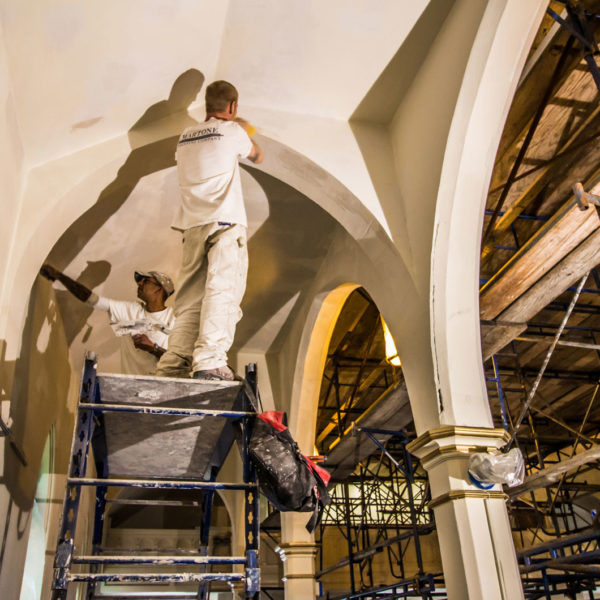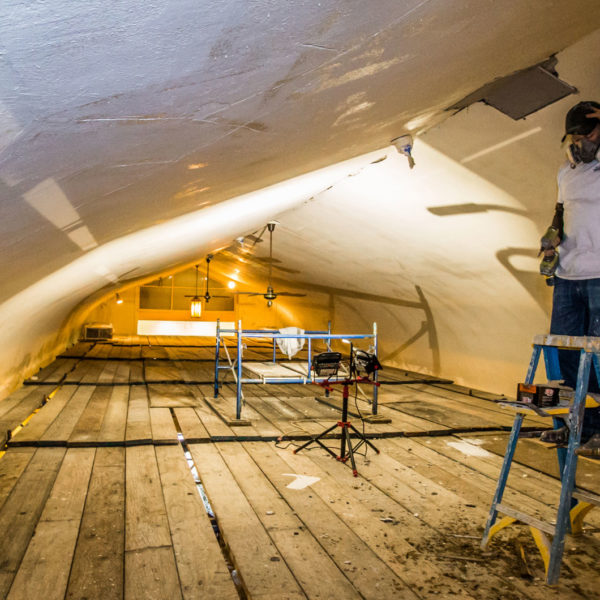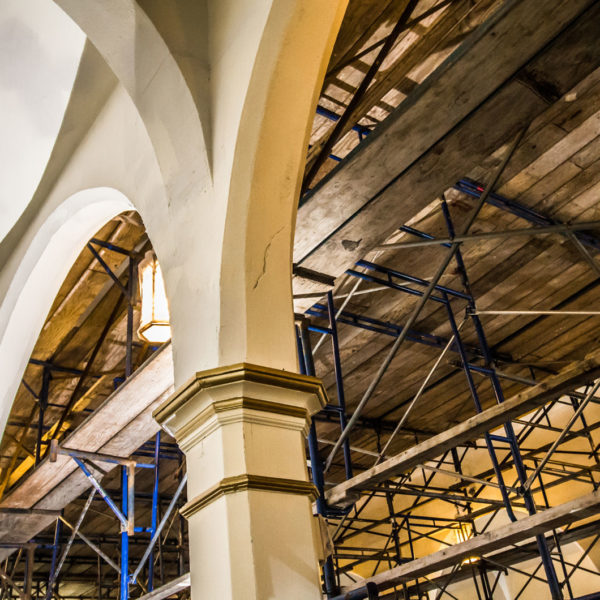About the Project
St. Joseph’s Parish is in West Warwick, Rhode Island near the Pawtuxet River, which famously provided the water power that attracted early American industrialists to build textile mills along its shores. St. Joseph’s was constructed to serve the growing population of Roman Catholic immigrants, who were drawn to the area by the promise of mill jobs nearby.[i]
Built in 1870, and like many landmarks of its time, St. Joseph’s features a Federal architectural design. The interior of the church was constructed using plaster produced and installed through traditional methods brought to America from Europe. Our job is to restore the plaster to its original state, matching the historic appearance.
Historical Context
Together with skilled masons and carpenters, plasterers and ornamental plasterers saw their trade flourish from the mid-18th century until the depression years of the 1930s.[ii] During this 200-year period, plaster was used extensively in the construction of walls, ceilings and decorative architectural flourishes. No surprise, given that plaster provided an extremely versatile and durable material. It’s strong, breathable, fire resistant, and reduces sound transmission. Plaster can be applied over brick, stone, half-timber, or frame construction. And, it can be molded, cast, incised, colored, stamped or stenciled. However, while the strength of plaster is evidenced by the durability of centuries-old structures — as an integral part of the building system, plaster is subject to the typical problems of water intrusion, structural movement, vibration and insensitive alterations.
Replace or Restore
Today, owners of period properties face the issue of deteriorating or decaying plasterwork. Replacing plaster is costly. The good news? Wholesale failure is uncommon unless a building has been abandoned and/or roofless for some time. Difficulties most often stem from outside agents such as water penetrating the walls, or the decay of timber lathing or floor and ceiling structures.[iii] Correctly identifying and addressing these underlying issues is key to reducing the repairs needed, and total project costs. Not to mention, restoration techniques enable the preservation of buildings and materials that chronicle our heritage.
Cause and Extent of Damage… Govern the Solution
At St. Joseph’s, Martone began with a careful study of the existing plasterwork.
The team determined that the initial construction followed a customary system to attach interior plaster to walls and ceilings. This consisted of 1/4″ x 1-1/4″ wooden lathing strips nailed 3/8″ apart against studs and joists. Then, a scratch coat consisting of sand, lime, and cattle hair was troweled on the lath and pressed through the slots so as to slump over and form “keys.” Next, a brown coat was applied to establish flat and plumb surfaces. Finally, a third or finish coat was applied that consisted of both lime and gypsum. Decorative units were the attached to the substrate using plaster as an adhesive.[iv]
To the delight of the Parish Board, we also found that the plaster at St. Joseph’s exhibits mainly cosmetic damages from building movement over the years, along with some deterioration from minor water infiltration. The structural integrity is sound so that cracks, holes, and bowed areas can be repaired without the need for wholesale demolition. Our team will focus on patching cracks, repairing holes, re-plastering missing pieces and repainting to match the color and texture of the original surface.
And, We’re Under Way!
For an active Parish like St. Josephs’s, our findings were especially well-received… which led immediately to the next project challenge. How fast could we get it done? Excerpts of Father Stowe’s message in the parish bulletin tell our story best…
The church was emptied after the 11am Mass last week. Once cleared, the cracks in the plaster looked a little bigger. I thought, “How in the world is this going to be done in two weeks?” Fast forward to Monday morning. Mike Martone and his men have been in full swing. Their hard work, expertise, communication, and efficiency are impressive. Within a twenty-four-hour window, I was thinking, “Will they even need two weeks?”
Author’s Note
While the findings at St. Joseph’s Parish are not always the case, we’ve found from our experience managing numerous similar restoration projects that historic plaster is a high-quality building material that can be repaired rather than replaced more often, than not. Often while offering a more cost-efficient solution, and the opportunity to maintain the historical authenticity of a treasured space.
[i] Rhode Island Historical Preservation Commission, Historic and Architectural Resources of West Warwick, Rhode Island: A Preliminary Report, 1987, pp. 19, 87
[ii] Flaharty, David, Preservation Brief No. 23, National Park Service, U.S. Department of the Interior, October 1990
[iii] Bolton, James, Conservation of Architectural and Archeological Heritage, 25 April 2012
[iv] ibid



